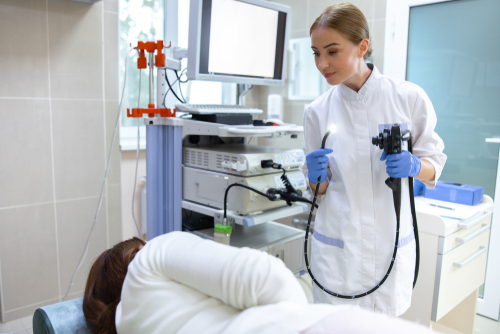ENDOSCOPY SERVICES
Endoscopies examine the interior passageways of the body. By using an endoscope, a long thin flexible tube with a camera at the end, physicians can look for ulcers, tumors, inflammation, bleeding, or infection. Through these services, your physician will be able to biopsy a particular area (obtain a tissue sample), remove a polyp in the colon, and stop any bleeding that may occur internally.
AHMC Anaheim Regional Medical Center offers endoscopy procedures of the gastrointestinal and respiratory tracts.
The Endoscopy/GI Lab is located in the basement of the hospital. For more information about our endoscopy services and the GI Lab, please call: (714) 999-3938.
Gastrointestinal Endoscopy Services
Colonoscopy
A colonoscopy gives physicians a view of your lower digestive tract, which is comprised of the colon and rectum.Physicians may use a colonoscopy to evaluate:
Abdominal pains
Change in bowel movement habits
Determine a cause for blood found in stools
Screen for colon cancer
According to the National Cancer Institute, colorectal cancer is the fourth most common cancer in both men and women. Colonoscopies are an important procedure because they can assist in the screening, prevention, and diagnosis of colorectal cancer. If polyps are found and removed, they may prevent the development of colorectal cancer.
Esophagogastroduodenoscopy (EGD)
An EGD, also known as an esophagogastroduodenoscopy, is a procedure that uses a small flexible scope with a camera at the end to look at several passage ways in the body: the small intestine, esophagus, and stomach.An EGD will allow physicians to identify causes of:
Heartburn
Internal bleeding
Abdominal pain
Problems swallowing
Endoscopic Retrograde Cholangiopancreatography (ERCP)
An ERCP, also known as an endoscopic retrograde cholangiopancreatography, is a procedure that allows physicians to check the tubes (ducts) that drain the liver, gallbladder, and pancreas.
Percutaneous Endoscopic Gastrostomy (PEG)
A percutaneous endoscopic gastrostomy (PEG) is used to directly put food, liquids, and medications into the stomach. This procedure is usually done for patients who have difficulty swallowing.An endoscopic examination is done first in order to assess the condition of the esophagus and stomach. Simultaneously, a physician will also determine where the best place to insert the feeding tube is.
Respiratory Tract Endoscopy Services
Bronchoscopy
Using a bronchoscope, a physician can look directly at the throat, larynx, trachea, bronchial pathways and lower airways.By looking at these specific areas, a physician can:
Diagnose and determine the extent of lung cancer
Find the cause of breathing problems or a chronic persistent cough
Take tissue samples from areas that need further evaluation

